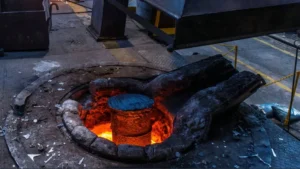This is a very important and practical issue. Induction furnaces are major energy consumers in the foundry and metallurgy industries. Even minor efficiency improvements can lead to significant cost savings and environmental benefits.

1.Optimize Operating Procedures
This is the most direct energy-saving method at the operational level. Induction furnaces operate at their highest electrical efficiency during full-power melting and at their lowest efficiency when holding at low power.
- Full-Power Rapid Melting: During the melting phase, maintain full power or near-full power (เช่น, above 90%) output as much as possible to convert the solid charge to liquid metal in the shortest possible time. Shortening the melt cycle is the core of energy saving.
- Reduce Holding and Waiting Times: Strictly avoid long periods of low-power holding. Once melting is complete, การกลั่นกรอง, การวัดอุณหภูมิ, sampling, and pouring should be finished as quickly as possible. If waiting is unavoidable, it is more energy-efficient to turn the furnace off (for short periods) than to hold at low power for a long time.
- Maintain a Proper Molten Level: Keeping a high level of molten metal in the furnace (“full but not overflowing”) helps improve thermal efficiency and reduces heat radiation loss from the furnace opening.
2.Schedule Production Reasonably
ก “cold start” is one of the largest energy drains for an induction furnace. Every time the furnace is started from room temperature, a massive amount of energy is consumed to heat the heavy lining, and this heat is lost when the furnace is shut down.
- Centralize Production Runs: เน้นงานหลอมภายในวันเดียวหรือกะเดียวให้มากที่สุด. หลีกเลี่ยงตารางการผลิตที่กระจัดกระจาย.
- การดำเนินงานอย่างต่อเนื่อง: รูปแบบการประหยัดพลังงานในอุดมคติก็คือ “ละลายอย่างต่อเนื่อง” ตัวอย่างเช่น, แทนที่จะปิดตัวลงเมื่อสิ้นสุดกะ, เตาจะถูกส่งไปยังกะถัดไปในขณะที่ยังร้อนอยู่ (แฮนด์ออฟที่ร้อนแรง), หรือการหลอมจะทำเป็นชุดต่อเนื่องกัน (ทีละคน) ภายในกะเดียวกัน.
- ใช้ความเฉื่อยความร้อนของซับใน: การผลิตอย่างต่อเนื่องใช้ความร้อนที่สะสมอยู่ในซับในอย่างเต็มที่, ช่วยให้ส่วนผสมที่ตามมาละลายเร็วขึ้นและกินไฟน้อยลง.
3.ปรับปรุงซับ (วัสดุทนไฟ) แนวปฏิบัติ
การบุเตาเป็นหัวใจสำคัญของเตาเหนี่ยวนำ; ทำหน้าที่เป็นภาชนะและเป็นกุญแจสำคัญสู่ประสิทธิภาพทางไฟฟ้าและความร้อน.
- ปรับความหนาของซับให้เหมาะสม: ซับในที่หนาไม่ได้ดีกว่าเสมอไป. An excessively thick lining reduces electrical efficiency (poor coupling between the induction coil and the molten metal), increasing energy loss. An excessively thin lining is unsafe. You must find the optimal balance between safety and efficiency based on the furnace’s capacity and design.
- Strict Ramming and Sintering: The lining must be rammed uniformly and densely. The sintering (furnace bake-out) process must strictly follow the temperature curve and timeline provided by the supplier. A poorly sintered lining (incompletely sintered or over-sintered) will have reduced insulation properties and durability, leading to electrical leakage or rapid erosion, which continuously wastes energy.
- Select Appropriate Materials: Use high-quality lining materials with low thermal conductivity, good insulation properties, and high resistance to erosion.
4.Strengthen Charge Material Management
The charge material (เศษเหล็ก, ผลตอบแทน, ฯลฯ) put into the furnace directly determines the time and energy required for melting.
- Increase Charge Density: Use dense materials, such as baled or sheared heavy scrap, whenever possible. Avoid light, bulky, หรือ “fluffy” scrap. Dense materials absorb magnetic energy more effectively and melt faster.
- Keep it Clean and Dry: Dirt, สนิม, น้ำมัน, and moisture in the charge material consume extra energy during melting (especially water, which requires enormous heat for evaporation and poses a safety risk).
- อุ่นค่าใช้จ่าย (ไม่จำเป็น): If conditions safely permit (เช่น, using a waste heat channel or a dedicated preheater), preheating the charge (เช่น, to 300-500°C) can significantly shorten melting time and reduce power consumption.
5.Optimize Power & ระบบทำความเย็น
An induction furnace’s energy consumption isn’t just in the furnace body; ยังอยู่ในระบบจ่ายไฟและระบบทำความเย็นที่รองรับอีกด้วย.
- รักษาปัจจัยกำลังสูง: เตาเหนี่ยวนำเป็นโหลดแบบเหนี่ยวนำและต้องมีธนาคารตัวเก็บประจุเพื่อชดเชย. คุณต้องแน่ใจว่าธนาคารตัวเก็บประจุทำงานอย่างถูกต้องเพื่อรักษาตัวประกอบกำลังไว้ (พีเอฟ) สูง (เช่น, above 0.95). ตัวประกอบกำลังต่ำทำให้เกิดการสูญเสียพลังงานปฏิกิริยาอย่างมาก (ส่งผลให้มีโทษด้านสาธารณูปโภคและความร้อนเพิ่มขึ้น).
- ควบคุมน้ำหล่อเย็นอย่างเหมาะสม: น้ำหล่อเย็นใช้เพื่อทำให้ขดลวดเหนี่ยวนำและแหล่งจ่ายไฟเย็นลง, แต่เป็นการขจัดความร้อนออกจากเตาอย่างหลีกเลี่ยงไม่ได้. ปรับการไหลของน้ำและอุณหภูมิให้เหมาะสมเพื่อหลีกเลี่ยงการระบายความร้อนมากเกินไปในขณะที่มั่นใจในความปลอดภัย. ตัวอย่างเช่น, รักษาอุณหภูมิของน้ำทางออกให้อยู่ที่ค่าที่ตั้งไว้สูงพอสมควร (เช่น, 50-60° C) แทนที่จะต่ำเกินไป (เช่น, 30° C) สามารถลดการสูญเสียความร้อนได้.
- ตรวจสอบการเชื่อมต่อไฟฟ้า: เก็บจุดเชื่อมต่อกระแสสูงทั้งหมดไว้ (บาร์รถบัส, สายเคเบิลระบายความร้อนด้วยน้ำ) สะอาดและแน่นหนาเพื่อลดการสูญเสียความร้อนที่เกิดจากการต้านทานการสัมผัส.







